The Savior Aerial robot is designed in a way that it can quickly move towards drowning people by user guidance and activates its savior system. This system releases life tubes for the drowning ones.
Contributed by | RTS Research Group
By hearing news about drowning’s at the Caspian Sea (north of Iran), we thought of finding a solution of saving human lives at the sea. For solving the problem, at the first step, we developed a surface rescue robot at RTS Lab as shown in the figure 1, the robot can be drove both manually and by radio control by the lifeguard to move towards the incident. If the victim was conscious he could catch the barriers and comes back and if not the lifeguard had to first find the victim from beneath water then throw him on the device and then return to the coast. After manufacturing and testing it successfully, we thought of building a robot with higher capabilities that could act quicker and more accurate in rescue missions and we came up with the Pars Aerial rescue robot idea.
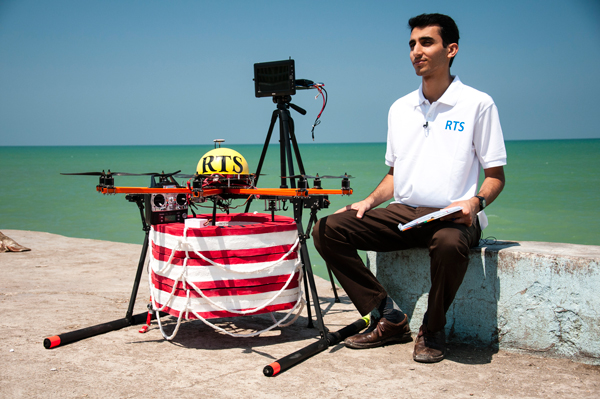
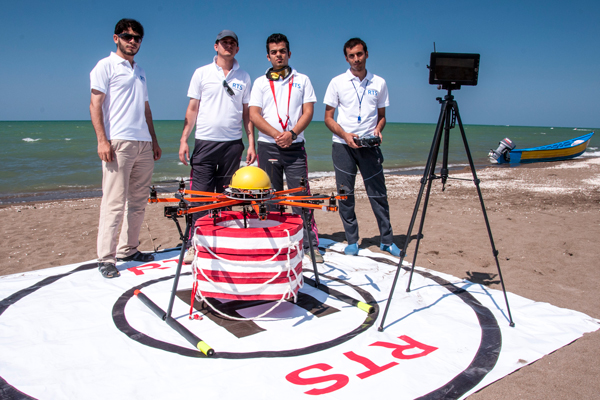
One of the challenges that lifeguards met is the case of several people drowning at the same time. This event usually occurs when one starts drowning and family, friends or other people go to save the drowning person and they get into a similar drowning situation. Sometimes it can be seen that up to 6 people have drown at the same time, like the unpleasant incident of 6 students drowning together at the Caspian Sea in July 2013.
Pars is an Aerial robot designed and made for saving human lives. The first purpose of building the robot is the relief of people drowning near coastlines. By developing its applications, it can be used in ships and off shore reliefs. It can also be used in other applications such as monitoring of marine and off shore structures, recording films and pictures from dangerous path ways for rescue missions, precise positioning. One of the features of this robot is Ability to save more than one life in a mission it can also track its path by GPS positioning and at the end of its mission it can come back home without the need of user guidance.
The robot’s tests have been taken at the Caspian Sea. Thirteen tests were taken in a 4 day period and the following aspects were analyzed:
Life vest releasing system performance, flight stability, search and rescue performance at day and night, Simplicity of robot’s control, comparing performance with traditional rescue methods, analyzing the deficiencies of robots design.
Pars can fly ten minutes in this design and its maximum speed is 7.5 m/s, thus it can be used in missions with a 4.5 kilometer radius range. Tests were completely successful and all of the expected goals were achieved. Based on the test results and considering the general rescue methods new ideas for developing Pars were achieved that will be revealed after careful scrutiny.
After completing the design and final corrections we will hopefully prepare the robot for introducing it to international markets although at the moment one of our main problems in this stage is financial support and we are looking forward to negotiate about sponsorship and investment.
The final test compared the performance between robot and human (lifeguard). The goal of this test was rescuing a drowning person in 75 meters away from coastline. As a result, robot done its mission in about 22 second however the lifeguard did the same in 91 second.
We also had another test taken at night. In this test LED Lighting is used to help user have a better sight to find the robot and life tube position.
Future work:
- We have considered many designs for the robots future applications for example:
- Life tubes to catch the drowning automatically
- Increasing flight range and decreasing rescue mission time
- Sound and image processing and controlling the robot with artificial Intelligence
- Landing on water for emergency situations
- It’s noteworthy to mention that this robot is designed for the first time and can make a huge revolution in robot applications for saving human lives.
The robots tests will be broadcasted soon.
After completing the design and final corrections we will hopefully prepare the robot for introducing it to international markets although at the moment one of our main problems in this stage is financial support and we are looking forward to negotiate about sponsorship and investment.
Owners of idea:
Amin Rigi, Saeid Talebi, Masoud Noroozi, Hossein Saffari, Majid Saeidi, Amin Mirakhorli
The robots design:
Idea: The Savior Aerial Robot (Pars)
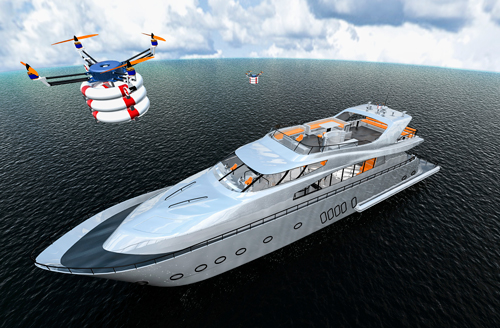
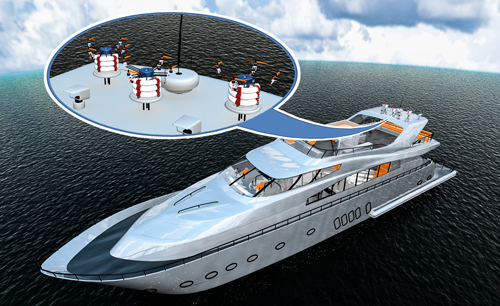
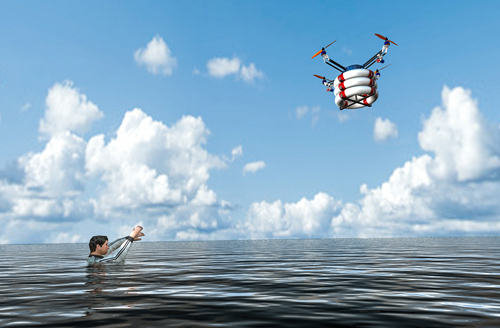
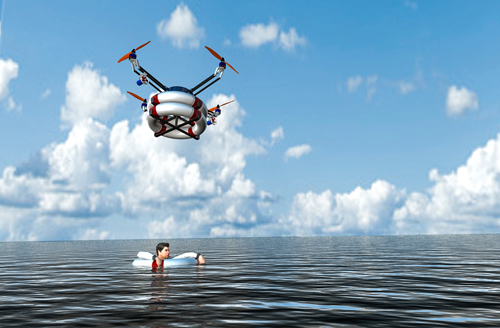
An Aerial rescue robot named Pars is being developed at RTS Lab.
Pars is an Aerial robot which is designed and made for saving human lives. The first purpose of building the robot is the relief of people drowning near coastlines. By developing its applications, it can be used in ships and off shore reliefs. It can also be used in other applications such as monitoring of marine and off shore structures, recording films and pictures from dangerous path ways for rescue missions, precise positioning and monitoring of off shore disasters and aid in firefighting.
The designed robot uses new technologies for guidance and navigation. Some of the technologies used are artificial intelligence, sound and image processing, autopilot search and rescue and a wide combination of sensor technologies. The robot is very simple and also very applicable and can play a significant role in saving the injured people.
The Savior Aerial robot is designed in a way that it can quickly move towards drowning people by user guidance and activates its savior system. This system releases life tubes for the drowning ones. Considering that many people drown all over the world every year, this robot can decreases the duration of rescue operations and save more lives.
Applied Innovations in This Method:
- The robot has the Ability to save more than one life simultaneously at a mission; for example, if several people simultaneously were sinking at the coast, this robot could send life tubes to each one very quickly.
- The robot is waterproof and it can land on the sea surface. When the robot faces an accident or in low battery situations it lands on sea, to not see more damage or sink.
- So far 3 pads have been considered for the robot that gives it the ability to save 3 lives in one operation; by using chemical materials for bloating the life pads, the pads can be increased to more than 15 in number.
- The robot uses artificial intelligence for accurate analysis of the condition it’s in.
- The robot is designed with a FLIR heating camera for recognizing the injured ones at night and also uses LED lightening to be recognized at night and activates its intelligence system when people shout for help.
- It is simply installed and applied in different parts related to marine issues, from coastline to installation in the ships and oil platforms.
- The robot is controlled from a central control cabin. In ships the robot has special platforms and is controlled from the ships control cabin. In case of an accident there is no need for starting up the robot, it launches from the applied platform and is always ready for flying.
- The robot can track its path by GPS positioning and at the end of its mission it can come back home without the need of user guidance. After returning, it lands on its platform and starts charging its batteries.
- A sea platform has also been designed for the robot. This platform used satellite data for its control and it uses solar energy for its energy. It is always in the water and the robots are ready for action. When a marine incident occurs it quickly operates and sends the robots to the event to help.
- We have considered many designs for the robots future applications including a robot manipulator and the ability to moving and install savior cables and there connection to other places.
What are the main customer benefits compared to existing solutions?
- The surface floating remote control robot for rescue in coastlines: The Emily robot which was made in Switzerland and known as one of 50 best inventions by the Times Newspaper in 2010 is a good example.
- It’s noteworthy that our robot has many advantages in comparison with the Emily robot that makes our robot unique. We can mention some of Emily’s disability as: 1-Emily can’t save more than one person simultaneously in one mission 2-It has difficulties reaching the injured when the coastline is too crowded.
- Related to ships and marine platforms, boats are usually used for saving people. This method takes a lot of time. At the first moments of the disaster Pars can be sent to the incident to do initial aid until the lifeguards arrive. The robot helps rescuers to have better control of the disasters situation and its role is to promote the saving operation.
- Saving by Airplanes and Helicopters: This method is one of the most applicable ones for saving human lives till now. The Pars robot plays a role to promote the saving operations here too.
- Simple manual control and guidance of the robot, in a way that each person without having high technical education is able to learn how to work with it within a few days and do the saving operations.
- The robot is Low weighted and is simply transported.
- The robots operation doesn’t depend on coastline conditions as like a stormy sea or a crowded sea (many people swimming in the coastline).
- Simple and quick access to the accident location: for instance, if a person falls from high coastline rocks in to the sea, saving the person might take a lot of time but by using this robot the time will decrease and on the other hand we will receive films from the robot that will help us estimate the depth of the tragedy and necessary equipment’s needed.
- The robot can be used in crises management for investigating the strength of the catastrophe and saving the injured. For instance the robot can be used within floods or earthquakes.
- The robot has the Ability to save more than one life within a mission; other methods don’t have this ability. For example, surface floating remote controlled robots or humans are usually unable to save more than one life but in many disasters many people might need help simultaneously.
How did you come up with this idea?
By hearing news about sunken people in Caspian Sea on the north of Iran, we thought about finding a solution for saving lives of humans who were drowning in the sea. According to statistics of our country, during the last 8 years, 46500 people have been in drowning situations in the Coast of the Caspian Sea and from this amount 1100 have died. For solving this problem, at the first step, we made a savior floating robot of beaches (shown in figures below) after manufacturing and testing it successfully, we thought of manufacturing a robot with higher capabilities that would be able to act in operations quickly and precisely and we came up with the idea of the flying savior robot. Our main purpose of making this robot is to save human lives. It is necessary to mention that before building the robot, we sent the idea of the robot to the first national congress of savior robots in Gorgan which was held by Red Crescent organization. The Pars robot was chosen as the “best idea” of the congress and this encouraged us to build the robot.
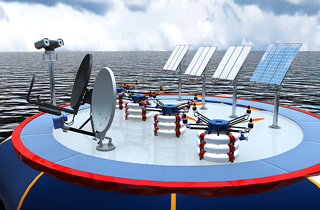
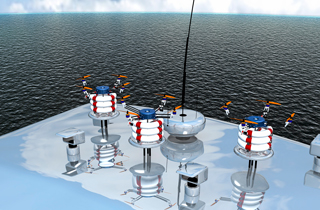
Aim groups and customers:
- Relief & saving Organizations, as like Red Cross and Red Crescent
- Lifeguard Federations
- Marine security companies
- Oil and gas industries for investigation of marine structures
- Oil and gas industries for marine relief missions
- Coastline police
- Ship owners and ship makers
- Firefighting organizations
- National Lifeguard Services
- Crisis management organizations
Describe the functionality of the robot:
The operations of some parts of the robot have been mentioned as follows:
The Savior Aerial robot and its mechanisms are controlled by motors, sensors, control circuits, mechanical systems and microcontroller programming. The machine uses several servo motors for controlling and releasing rescue pads (tubes). These servos receive a signal from the microprocessor and pull a latch that causes the release of the life pads. Considering the specialization of the team members in making The robots platform is used for charging its batteries while not in action.
The Method of charging: in first mode, the connection between the platform base with the battery is logged off and it will connect when the charge of the battery is lower than a determined limit. The base uses conductive small blocks for charging the batteries.
Does the concept work now?
Manufacturing the primary functions of the robot has successfully ended. Because of the huge amount of the robots capabilities, we have not yet implemented all of them. For example, we have used three axel accelerometer sensors and three axel gyroscope, Gps, Barometer and compass sensors now but we haven’t applied ultrasonic sensors yet.
How much fund is needed for industrialization the plan?
We need financial support and investment for mass production of the plan. All expenses of building a prototype has been provided by the team up to now.
Expense for industrial prototyping of the robot will be around about 30000 to 40000 dollar.
The content & opinions in this article are the author’s and do not necessarily represent the views of RoboticsTomorrow
Comments (0)
This post does not have any comments. Be the first to leave a comment below.
Featured Product
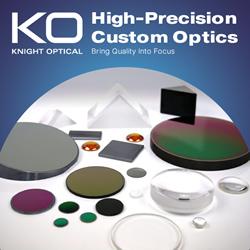
Knight Optical - Unlocking Precision for the Robotics and Automation Revolution
In the era of Industry 4.0, automation and machine learning drive the future. Knight Optical stands at the forefront, collaborating globally to supply precision optical components that power the robotics and automation sector. From UAVs, drones, and robotics to machine vision, LiDAR-driven car sensors, and renewable energy, our optics empower innovation. Optical components play an important role within the industry, including: Optical windows and domes safeguard systems in unmanned vehicles while preserving the field of view for cameras. Infrared lenses with aspheric surfaces elevate thermal imaging. Optical filters excel in machine vision, with colour glass, interference, and dichroic filters in our stock. Knight Optical provides stock components and custom solutions made to your exact specs. With every component undergoing rigorous metrology and QA checks before shipment, you are sure to experience true precision, innovation, and assurance.

